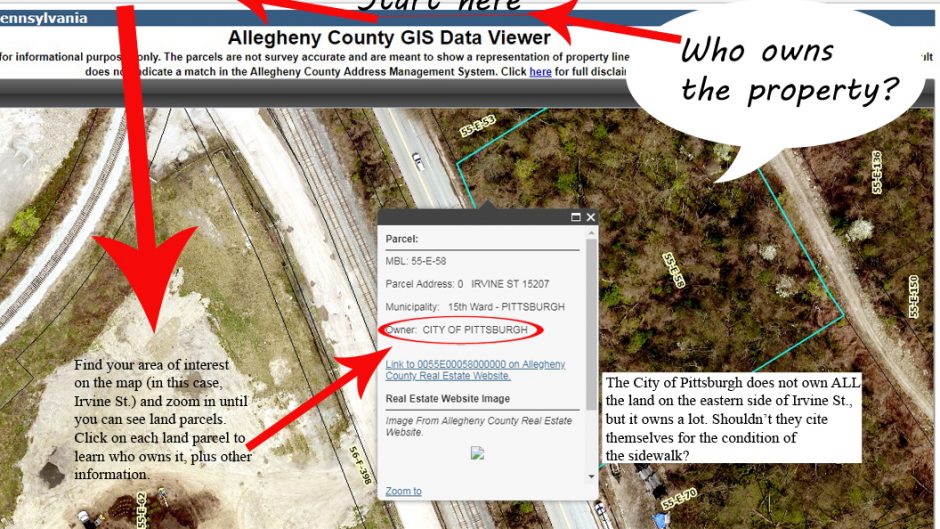Construction Projected for Summer 2022
Long-needed sidewalk construction on Irvine Street between Hazelwood and Greenfield avenues got more attention recently when updates to the project’s Engage PGH webpage raised questions about funding.
Although the fact sheet linked from the webpage stated “this project is only funded for design. DOMI [Pittsburgh’s Department of Mobility and Transportation] is investigating potential sources for construction funds…,” construction is funded and slated to begin in June.
DOMI’s chief engineer Eric Setzler said the project received a grant of $120,000 from the Pennsylvania Department of Community and Economic Development, plus $1 million in funding from the $335 million Pittsburgh received as part of the American Rescue Plan (ARP).
Mr. Setzler reported that the Irvine Street project mainly consists of sidewalk and curb replacements with “updated ADA [Americans with Disabilities Act-compliant] ramps at the intersections.”
“We would like to get as much curb reveal as possible,” he said, referring to the height of a curb that helps provide separation from the road. As layers of asphalt are added to a road over time, its level rises closer to the adjacent sidewalk. Other Irvine Street improvements include adjusting drainage from the sidewalks and adding a small retaining wall to “hold the slope back”—especially near the Greenfield Avenue end of Irvine Street. The area currently has rock-filled wire cages called gabion baskets.
Mr. Setzler added that the project is “on a good track,” with design scheduled to wrap up by late January.
Run resident Barb Warwick noticed the outdated fact sheet and commented on the page, along with several other community members, calling for construction funds to be taken from the budget of the unpopular Mon-Oakland Connector (MOC).
“$12 million is a lot of money and it’s just sitting there in DOMI’s coffers,” Ms. Warwick said, referring to the estimated MOC budget. “Now that everyone is finally acknowledging how misguided DOMI’s plan to build a shuttle road through Schenley Park really was, we can start using that money for mobility improvements the people of Pittsburgh actually need.”
Regarding the MOC budget, Mr. Setzler said, “I am seeing about $8 million [of City funds], not counting anything from PWSA [Pittsburgh Water and Sewer Authority].” He mentioned the $4 million difference had been redirected in the 2021 budget through an amendment introduced by District 5 Councilman Corey O’Connor. PWSA has a budget of more than $42 million to complete a stormwater project on the same land as the MOC.
The MOC, slated to be put on hold by incoming Pittsburgh mayor Ed Gainey, proposed connecting Oakland university campuses and the Hazelwood Green development through the park’s Junction Hollow section and two adjacent neighborhoods—The Run and Panther Hollow. Affected communities including The Run, Panther Hollow, Greenfield, South Oakland, and Hazelwood created their own plan for how MOC funds should be spent instead: Our Money, Our Solutions (OMOS).
The ARP funding arises from controversy as well. When it was announced in July 2021, Mayor Bill Peduto drew criticism from constituents who said he needlessly rushed to set a major spending agenda that prioritized infrastructure above mitigating COVID-19-related harms, such as evictions.
Anna Tang, a community organizer with BikePGH, received an email alert about the page update on Dec. 3; she forwarded it to her contacts in the Greenfield/Hazelwood area. “It’s my job to let the public know about this stuff,” Ms. Tang said, speaking as a citizen familiar with City websites rather than as a representative of BikePGH.
“This is an important corridor for all modes of transportation,” Ms. Tang remarked, “and it seems like the most vulnerable users are almost always last to get the infrastructure attention they need. [The sidewalk repairs] couldn’t come soon enough.”
“To be 100% honest, there’s not a whole lot of things to provide feedback on,” Mr. Setzler said of the project’s Engage PGH webpage. “But we still want to put it out there and let people see it.”
Although other city departments have been sharing their projects on Engage PGH for longer, “DOMI is catching up,” Mr. Setzler added. “Going forward [Engage PGH] will be our main source for sharing project information. In general, projects will still have outreach to community groups and public meetings”—virtual or in person.
As of Dec. 14, the project page had an updated fact sheet and a new “virtual public plans display.” The display features maps and a schedule that projects construction will take seven months. In addition, a new feedback form was placed on the page above the existing 140-character comment field. You can also create an Egage PGH account to receive email alerts about upcoming projects in areas you choose from a list.

Recent Comments